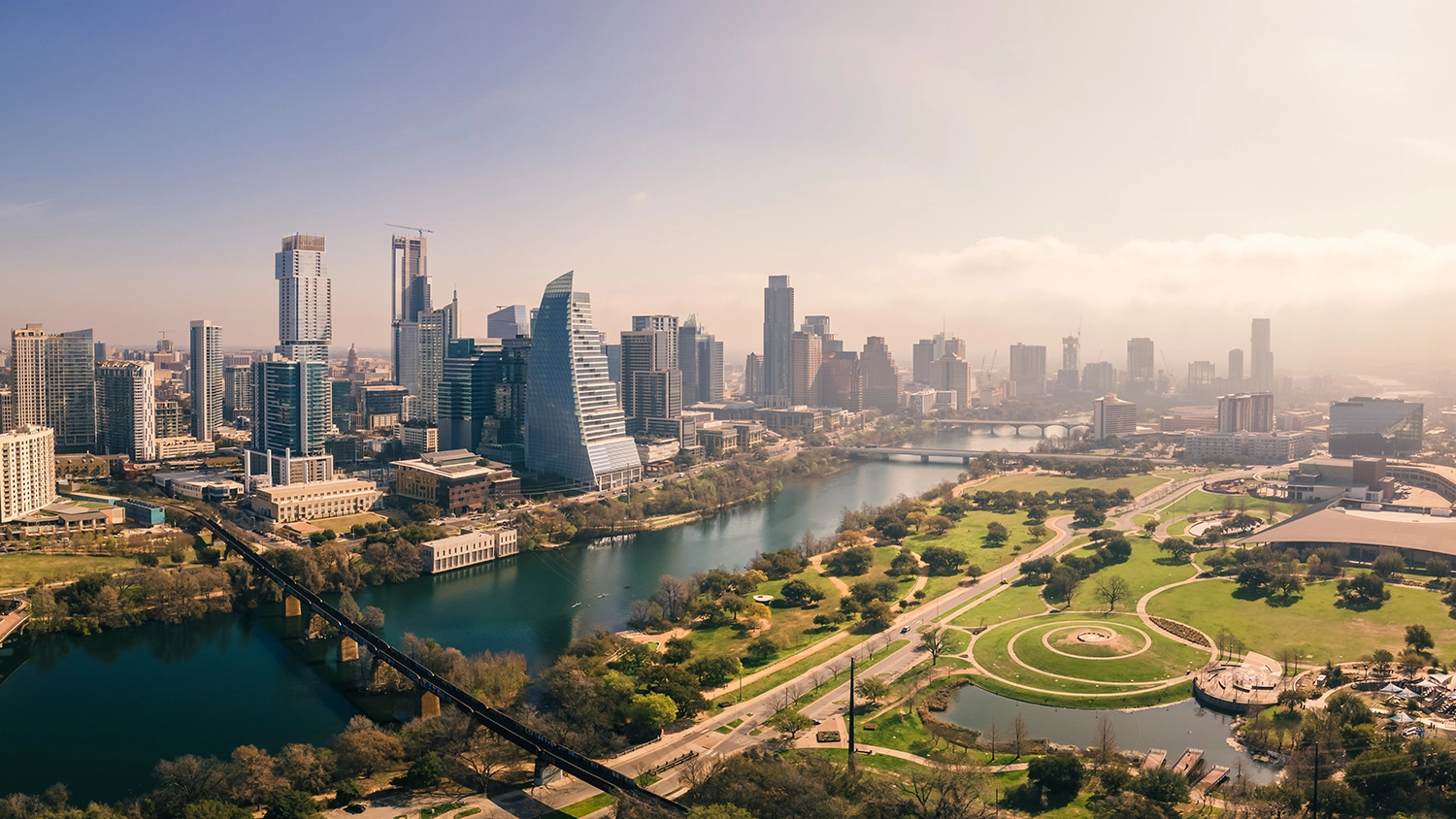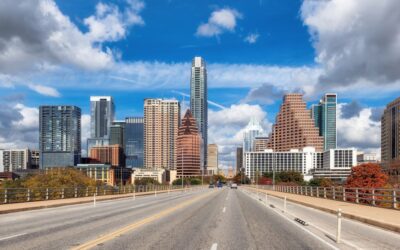After 20 years of leading robust economic development efforts in the Austin area, it may come as a surprise to hear Gary Farmer admit the job is as hard as it has ever been.
That’s partly due to the region’s success. Central Texas has long been viewed as the poster child for economic development efforts, dating back to when Samsung Electronics Co. Ltd. picked Austin for a factory in the 1990s, or in recent years when companies such as Oracle Corp. and Tesla Inc. moved their headquarters here.
The other reason is competition. More than 50 cities have traveled to Austin over the last 15 years to try and emulate what Opportunity Austin has built. Many are now mirroring it, pooling private sector money and brainpower for the wider economy’s sake. Case in point: Greater:SATX in San Antonio has raised $39.5 million to up its economic development game. Other states are using incentives to beat out Central Texas for big deals, like the Micron Technology Inc. chipmaking factory that went to New York instead.
“The competition is as strong as it’s ever been, in my experience,” said Farmer, president of Heritage Title Company, longtime chairman of Opportunity Austin and its interim CEO. “I think that we can still compete and win – and we will.”
It’s with that mindset that Farmer and the rest of the Opportunity Austin staff on Sept. 6 announced the launch of “Opportunity Austin 5.0,” the group’s next five-year strategic plan. It’s the first strategic plan since a split from the Austin Chamber of Commerce and will be funded by a budget nearing $35 million, or $7 million annually. Plans include luring more international companies, building out target industries such as life sciences, better tailoring workforce opportunities and making improvements to quality of life.
The plan comes at a critical point in the region’s maturity. Business leaders have said economic and population growth in recent years have led to concerns about workforce availability, housing affordability, transportation and public safety. Experts say now that Austin has a high-performing economy, and addressing these challenges will ensure the region will maintain its competitive advantages and continue the business attraction efforts that have been the foundation of Opportunity Austin’s success.
“The challenges that we face in the greater Austin region, (other cities) are facing the same challenges in every part of this country,” said Tony DeLisi, senior manager at Ernst & Young Global Ltd., which was tasked with writing and researching the strategic plan. “As others start to break down their silos and effectively be themselves, we’ve got a lot that still distinguishes us.”
Economy moves from partly to mostly cloudy
Back in 2003, economic growth in the Austin area was “stuck in neutral,” according to Opportunity Austin’s plan. The region was the 39th largest metropolitan area economy and struggling to recover from the dot-com recession. One of every four manufacturing jobs — led by a 30% decline in semiconductors, computer hardware and electronic products — disappeared and unemployment doubled to nearly 7%.
It’s been the opposite since. Austin now ranks as the 22nd-largest U.S. economy, with a regional gross domestic product of $200 billion — a 142% increase that is second to only Silicon Valley among the 50 largest metro areas, the report said. The region added more than 750,000 jobs since 2004, driven by manufacturing as the booming semiconductor and electric vehicle sectors have ramped up in recent years.
“Twenty years ago, before Opportunity Austin began, most folks didn’t think about Austin as a place of growing business or entrepreneurship — a lot of people in the region didn’t realize it,” DeLisi said. “The story has gotten out.”
Despite that success, many headwinds remain, said Dirk Mateer, professor of instruction in the economics department at the University of Texas. While he predicted at the start of the year that Austin would be “cloudy with a chance of showers,” he now sees it as mostly cloudy.
Among the warning signs is the amount of vacant office space, affordability challenges and the waning real estate market, although he admits the latter had to come down to normalize. Companies and people are also avoiding historically vibrant areas like downtown and are instead going to suburban areas, creating traffic and growth bottlenecks, he said.
“I think Austin is stuck between a Round Rock and a Dripping Springs,” Mateer said. “That’s not a bad thing because it’s the metro area that ultimately counts, but that’s not how a lot of people in Austin see it. Their impression of Austin is not driven by the suburbs, it’s driven by what’s happening in the city.”
That opinion tracks with what business leaders are seeing. Accounting and consulting firm Ernst & Young conducted a survey of 228 business leaders as part of the strategic plan. While Austin was highly ranked by respondents on things such as economic health, as a place to do business and as a place to live, they otherwise pointed out concerns over their ability to hire workers, access to materials, water and wastewater, housing affordability and transportation.
Ultimately, the biggest issue that business leaders are dealing with is hiring talent, said Ali Khataw, who is the 2023 chairman of the board of Austin Chamber of Commerce, which represents nearly 1,800 businesses. As the city has gotten more expensive, he said the quality of life that Austin is known for is no longer “equitable to everybody,” making it harder for some employees to live here.
“But I feel personally that the attraction is that we can still open businesses. We’re still a very business-friendly city,” said Khataw, who is also the CEO of Encotech Engineering Consultants. “Talent is a big issue and it’s hard to find talent nowadays. … We are trying to work toward improving quality of life, but it’s the hardest part, even for my own business.”
Despite the concerns, it’s not all bad. Austin’s average wages have increased more over the last decade than any other metro outside of San Jose, spiking to $74,300 in 2021 compared to $46,700 in 2010. Unemployment rates remain lower than both the U.S. and Texas averages. And, Austin has outpaced peer cities in a variety of metrics, including employment growth and wage growth.
“The good side is people still want to come to Texas, it’s still a low-tax state,” Mateer said. “If you’re coming from a state that’s not as conservative as Texas, then you’re looking for the blue heartbeat, and that’s Austin. Companies still want to relocate here. So, in general, the news is good, it’s just not quite the way it was.”
‘An economy that we would all hope for’
Those issues are the ones that Opportunity Austin is hoping to address. The group mainly leads business retention and attraction efforts and fosters startups and innovation. They claim to have helped create nearly 521,000 jobs in the region since its 2004 inception, equating to two out of every three new jobs in the area over the same time. Opportunity Austin has also aimed to diversify the economy to withstand future recessions and diversify the workforce.
The new 81-page plan is aimed at building out “an economy that we would all hope for,” Farmer said, by focusing on four priorities: refocusing business recruitment on emerging industries, connecting to global markets, filling the talent pipeline and improving quality of life.
Big priorities include tapping into the international market by doing things like increasing international trips, pursuing more trade agreements, establishing an international investment fund, and better leveraging international events like South by Southwest and the Formula One U.S. Grand Prix. That could also include local companies expanding abroad.
Farmer said Austin is a good locale to do so because of its existing diverse community — he pointed to Austin’s proximity to Mexico and that the city has infrastructure for many Asian communities, with Asian churches, grocery stores and more. Plus, Austin has a reputation of acceptance and is younger and more educated than most cities.
“I like to tell people my age that the next three people you are going to run into on the street are younger and smarter than you and me, and that’s a good thing because it’s forward-looking from an economic development standpoint,” Farmer said. “Our strong suit is the fact that we are welcoming, friendly and open people and we will assimilate those folks in so they have not only a successful opportunity with regard to their business but a quality of life as well.”
DeLisi added that international companies are already coming here, and that they can do a better job of taking advantage of things like federal incentives. Foreign companies that have expanded in the Austin area include South Korea’s Samsung, and its suppliers, like LS Electric in Bastrop and HBPO Plastic Omnium from Germany, have expanded to the area in recent years.
“If you’re a business in America and you haven’t heard about opportunities in Austin, your head is probably in the sand, and that’s due to work over 20 years here. But with the international businesses, the word is getting out more,” he said. “The playing field is ripe for this and it can only grow further.”
Austin has always targeted certain industries, like the semiconductor industry, though those priorities are changing. Data from the Chamber shows that while industries like semiconductor and information technology and software are increasing, others like entertainment, content creation and nonprofits are declining.
One new emerging industry is life sciences, and Opportunity Austin would like to see an innovation district created in downtown to accommodate that.
John Boyd Jr. of Florida-based site selection firm The Boyd Company said there’s been an uptick in foreign companies and those in life sciences looking at the Austin region. He said the former is caused by demographic shifts, presence of pharmaceutical companies and educational offerings in the region, like medical schools. The latter is because of the same benefits that attract companies to Texas, like incentives, no personal income tax, proximity to ports and expanded air routes.
“Austin is a global city because of the talent. Central Texas enjoys very strong linkages to the global marketplace,” he said.
Austin also has an advantage when it comes to emerging technologies, he added.
“Opportunity Austin would be wise to continue to promote the abundant AI skillset in the labor market,” Boyd said.
Partnerships are key
If there’s a key to the success of the strategic plan, it’s cooperation.
Economic development in the region has been like musical chairs lately, between the split of the Austin Chamber and Opportunity Austin, changes in leadership among groups such as the Greater San Marcos Partnership, and the emergence of other economy growers, like the Williamson County Economic Development Partnership run by former Austin Chamber executive Dave Porter.
Farmer said taking a regional approach is key, saying they are “agnostic as to where a company might locate” as long as it’s in the region.
Opportunity Austin is aiming for more regional partnerships, starting with the Chamber. It also wants increased diversity on boards. So-called super regional partnerships, like the one Austin has with Greater:SATX, will be crucial, Farmer said, to accomplish goals such as making the I-35 corridor the home to the global electrical vehicle industry.
Austin Chamber President and CEO Jeremy Martin called the partnership with Opportunity Austin “incredibly productive for nearly 20 years,” adding that they are excited about what the new chapter means for the region.
One example of the regional approach could be making improvements to quality of life. The report notes that the way Opportunity Austin sees it, the housing market is at crisis stage, mobility improvements are needed and public safety is a growing concern among business leaders. Solutions include advocating for local policies for housing development and density, accelerating regional mobility projects like the I-35 expansion and more airport flights, being more involved with public safety advocacy, and creating a regional housing strategy.
Other ideas include filling the talent pipeline. Farmer is especially proud of the Make It Movement program, which helps students who aren’t going to a four-year college get internships and attend certification classes, so they have a skill out of high school that can get them a high-paying job.
“The issues or concerns that we have are not unique or special,” Farmer said. “What can be unique and special is how we address those issues.”
When it comes to labor, the biggest challenge is having the skilled labor to fill available positions, said Tamara Atkinson, CEO of Workforce Solutions Capital Area. From 2021 to 2026, job growth in the region is forecasted to grow 12.5%, which is nearly three times more than what’s projected for the U.S.
It’s on regional partners to make sure companies in industries that are expanding can fill those jobs with training, upskilling or apprenticeships. She called economic and workforce development “two sides of the same coin.”
“For economic development to be successful in company recruitment and expansion, it really depends on a workforce that can satisfy those growing employers’ needs,” Atkinson said. “We need the partnership and collaboration with economic development to bring the jobs and ensure that jobs remain here in Central Texas.”
Another challenge for the region is consistency in incentive policies. While cities around Austin have been more apt to incentivize companies, providing tax breaks to everything from a Home Depot store to a building to be used for downtown revitalization to luring big industry suppliers, Austin and Travis County have largely resisted it.
“The truth of the matter is the city of Austin and or Travis County are not really engaged in incentivizing companies. I would suggest that they should be for the appropriate company,” Farmer said. “Most people don’t understand incentives. Incentives make the jurisdiction money. They don’t cost the jurisdiction money. The company that’s incentivized will come and create the value that produces the tax and then you’re simply sharing a piece of the tax that they create by being here. If they don’t come, the value is not created nor is the related tax. Most people think we’re opening up the treasury and handing out bucks. Not true.”
Austin Mayor Kirk Watson said in a statement that while city leaders are always open to partnering on things like infrastructure, workforce training and other programs, he argued that the economic development tools they have are very limited and don’t lend themselves well to regional partnerships.
“I’ve argued for better regional tools for decades,” Watson said. “My philosophy remains: If the region benefits, Austin benefits. And, if Austin benefits, the region does. So we should all be very strategic when it comes to offering financial incentives to ensure the sum is stronger than the component parts.”
For the first time in years, Austin city staffers are discussing incentives now for a large company, NXP Semiconductors, to expand. It remains to be seen if the City Council has the stomach to OK such an incentives deal.
A representative for Travis County Judge Andy Brown, who oversees a county that has a moratorium on incentives, declined to comment.
With the plan in place, Opportunity Austin has a first step it needs to make: hiring a CEO. Farmer said the “process is going very well,” labeling the number of applications as “enormous.”
“I think we’ll elect a pope sooner rather than later. We’ll see white smoke sooner than later,” Farmer said.
Only then will it be full steam ahead on Opportunity Austin 5.0.
“This is our chance to advance the ball in this Central Texas region. I’m excited about the buy-in from different communities in the region, I’m excited about the diversity that all of us bring together, I’m excited about the awareness that the business community has about the imperative of this program,” Farmer said. “The business community has been very generous in support of Opportunity Austin for 20 years, and I believe they will do so again.”
———-
Originally written by Justin Sayers – Staff Writer for the Austin Business Journal









